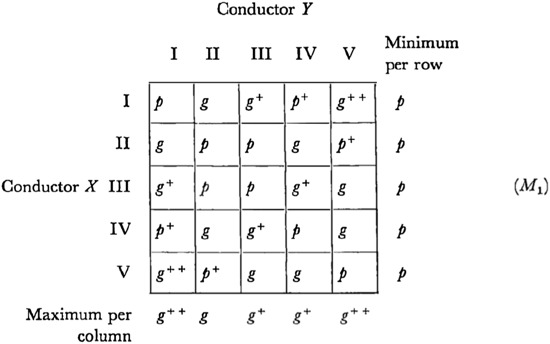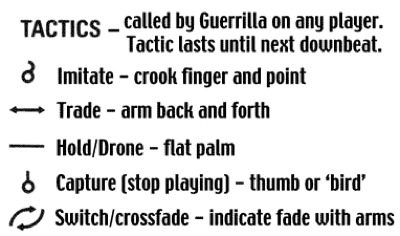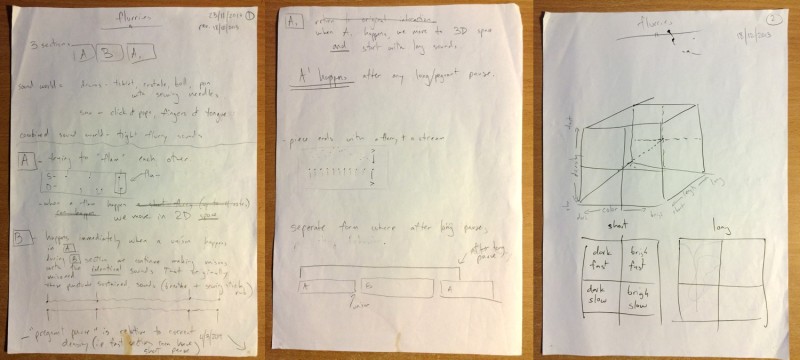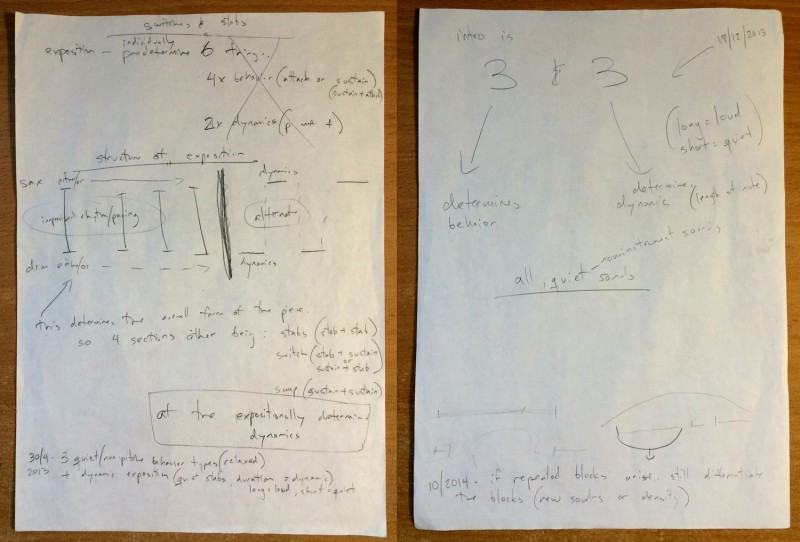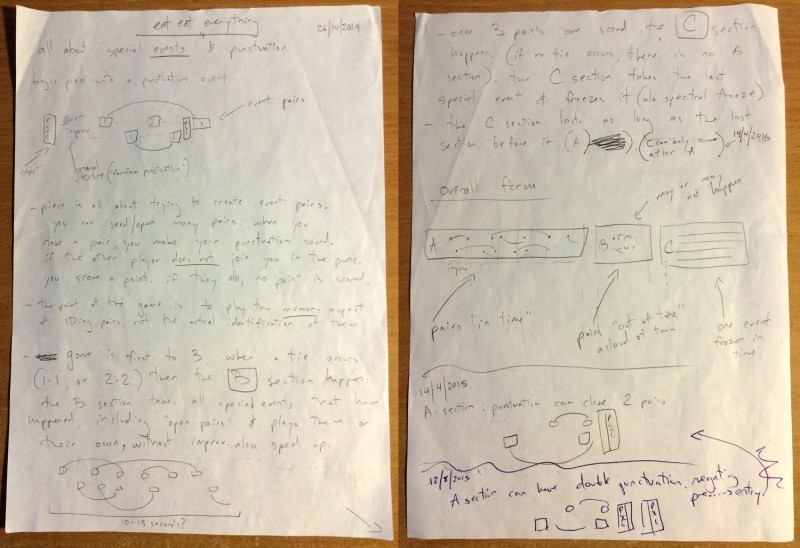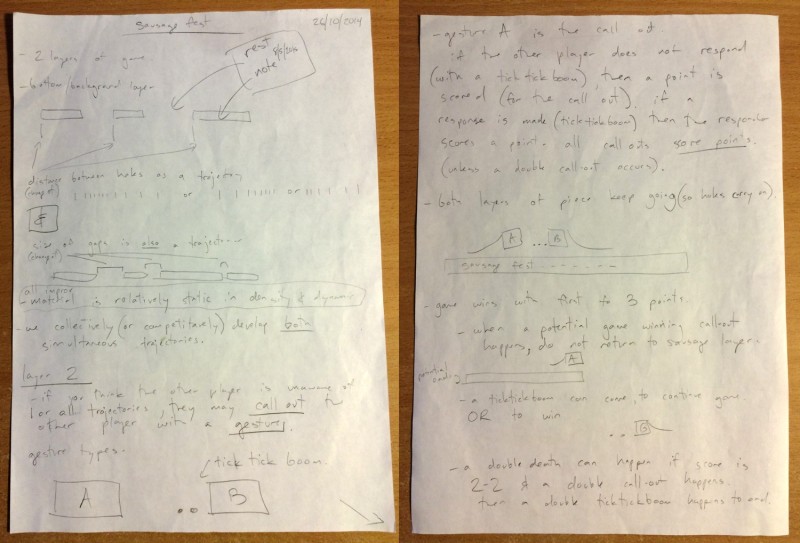strikethrough me & you – Battle Pieces

“Don’t hate the playa, hate the game.” — Ice-T
The Battle Pieces are a series of pieces composed, and performed, with Sam Andreae (as strikethrough me & you) which focus on complex games, improvisational etudes, and competition. The idea for the Battle Pieces came about during a rehearsal of a free-improv duo we had been developing where we decided we wanted to expand on what we were doing together, while still retaining improvisational freedom. This eventually took the form of the Battle Pieces. Essentially each Battle Piece is a game, but beyond being an improv game, it is also competitive, and generally deals with an aspect of improvisation that we want to explore further and/or improve on.
///////////////////////////////////////////////////////////////////////////////////////////////////////////////////////////////////////////////////////////////////////
Battle Pieces
So before I get into the Battle Pieces, it’d be foolish not to start with a yo momma joke.
Yo momma is soooo bad at improv endings that…
strikethrough me & you is a duo with Sam on tenor sax and me on drums. We had each been working on setups that involved solo improv on electronically augmented instruments but wanted to explore something using only stripped-down acoustic instruments. We initially began with just free improv, but during the compositional process of iminlovewithanothergirl.com Sam and I began testing out some of the formal materials (A/B/C pages) from that piece in a duo context. Some of the motivation to do this was to move away from the established canon of tenor sax and drums in free jazz. Those instruments just screamed “FREE JAZZ!” And as we all know, jazz is stupid. This exploration led us to expand and exaggerate the challenge/etude nature of iminlovewithanothergirl.com until the point that it became a competition – a battle.
This led to the idea of a “Battle Piece”: a musical game/challenge where winning and losing had material consequences in the piece. Much like in iminlovewithanothergirl.com, the actual content is not prescribed in any way. In these, the interaction is the composed material of the pieces. It is the idea of interaction as content.
The implementation of game theory in music has a history. Xenakis‘ implementation of game theory in pieces like Duel, although groundbreaking, lacks legibility in terms of the audience perceiving the actual interplay composed into the piece. The mechanics of the piece are primarily focused on balancing the zero-sum characteristics of matrices rather than aesthetics or non-mathematical interplay (Xenakis 1971). That isn’t to say that legibility (of the rules) is terribly important in Battle Pieces, but even the more complex methods of interaction produce legible artifacts, primarily in the form of visible emotion. Much like how it is not necessary to understand the rules of an unfamiliar sport in order to enjoy the game in some manner, the mere fact that there is visible interaction produces a kind of legibility which can be appreciated on its own merit. As Sam put it, “If we work hard enough on the interactions themselves so that we’re clear in them–clear on what our roles are–then it should generate quite strong musical results regardless of whether we tell people how we’re doing it” (Andreae 2013).
The general approach used in Battle Pieces has more in common with Zorn‘s game pieces than they do with Xenakis’. Zorn says of his motivation to create game pieces, which formed most of his compositional output from the late 70s to the early 80s, culminating in Cobra, that he “wanted to find something to harness the personal languages that the improvisers had developed on their own” (Duckworth 1999). So the solution for him was “to deal with form, not with content, with relationships, not with sound” (Duckworth 1999). This idea of relationships, or interaction, is a central concern in the Battle Pieces.
Although I was not directly inspired by the work of Christian Wolff, there is some similarity to the tension and confusion he worked with in his ensemble pieces of the 50s and 60s. Wolff’s use of relational notation, instructing performers to begin before/after a sound they have heard, or play a sound lower/higher in pitch to an existing note, gives the music a sense of immediacy and tension that would not be possible to arrive at another way. Even the pacing of the music is affected by these types of ‘games’, or more simply put by Philip Thomas (a long-time performer of Wolff’s music), “confusion is [used as] a rhythmic device in Wolff’s music” (Thomas 2014).
All Battle Pieces are composed collaboratively during rehearsals, with both of us contributing to the concepts, gameplay, rules, and mechanics of each piece. Although some close friends have tried the pieces out, they are meant to be performed only by Sam and me. The identity of each piece is made up of not only the rules/game/instructions and the type of material we improvise around, which can evolve over time, it is also made up of our personalities. As musicians, performers, and human beings, our personalities and general sense of play make up a big part of the Battle Pieces’ identities.
The core ideas for many Battle Pieces emerge from discussions following free improvisations during strikethrough me & you rehearsals. We sometimes end up finding something about the improvisation that could have been better and link that to tendencies or behaviors that we have as improvisers/performers. This leads to the creation of a piece, or pieces, that tackles that specific aspect of improvisation (endings, space, synchronicity, memory, density, etc.). Through learning, rehearsing, and performing those pieces we improve on the improvisation skills that we had originally found lacking. This process often leads to pieces becoming obsolete as they are no longer challenging or have become part of our general improvisational language and skill set, making the conception/composition/performance/obsolescence of Battle Pieces a microcosm of the feedback loop and intertwinement of my general practice.
The scores that we play from are the instructions for the pieces scribbled onto A4 sheets of paper, as can be seen in the sketches included with each commentary. Since we write the pieces for ourselves there is no need to create thorough notations for each piece, but rather, we jot down a compact set of instructions that we can quickly read to remind ourselves of the rules of the game. A long-term goal, once we have 78 compositions, is to have the instructions for each piece printed on Tarot cards, so that we can shuffle them and pull out cards (pieces) at random during a performance.
In the next section I will present the instructions, sketches, videos and recordings, along with explanations of the instructions, compositional thinking, and performative insight, of the following Battle Pieces:
- yo momma – the creation and baiting/trapping of improvisational endings
- glitch beat – variation/exhaustion, internal/external learning, and repetition
- flurries – spectromorphological acoustic sound masses with fixed compositional elements
- switches – unison playing with encoded/decoded musical information
- eat, eat everything – memory, special events, and in/out/frozen time performance
- sausage fest – space, silence, trajectories, and collective gesture playing
- strains – rock, paper, scissors meets polyrhythmic memory games intertwined with improv
- elbows – the creation of rapid shifts in musical material
- AB(B)A – discovering and transplanting a spontaneous musical games
- pop song – repetition, memory, and form in a freely improvised context
///////////////////////////////////////////////////////////////////////////////////////////////////////////////////////////////////////////////////////////////////////
yo momma
yo momma is the very first Battle Piece Sam and I composed together. It was quickly scribbled on the back of one of the sketches for iminlovewithanothergirl.com during the rehearsal where we decided to change musical gears. The main focus of yo momma is the ending. Endings can be elusive in improvisation, even among seasoned performers and especially among inexperienced improvisers. The ability to not only spot but execute an ending in improvisation is a valuable skill, or as Fred Frith put it in an improv workshop, “If you see an ending, take it!” (Frith 2007)
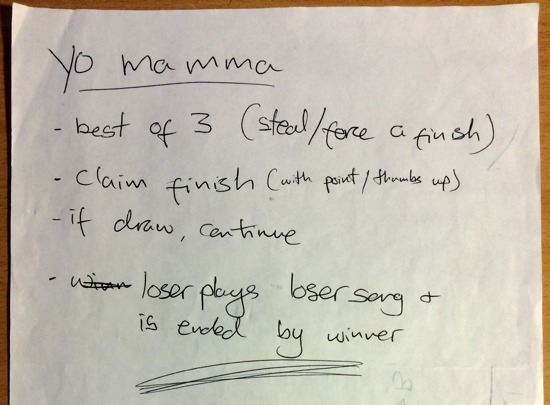
Having listened to nearly a decade of improvisers wanting to get in the last word, musically, at The Noise Upstairs, an improvisation-based collective/night I co-run, I have developed an allergy to this inability to end. This tendency to plow through a possible ending shows little regard for flow and sensitivity to context, and demonstrates a lack of critical listening, which is the centerpiece of highly interactive improv. yo momma is vitamin kick-you-in-the-ass for the inability to find endings.
Here is the complete text/score/instructions for yo momma:
yo momma is a competitive music game. The objective of the game is to steal an ‘ending’ from the other player. You accomplish this by recontextualizing what the other player is doing as a possible end to the piece.
When you catch the other player in an ending you make a ‘thumbs up’ gesture to yourself, indicating your claim to the ending. If both players claim the point, no point is scored.
You may ‘escape’ an ending by skillfully negotiating a context to continue. If the player attempting to create the end feels you egregiously played through an attempted ending, they may make a claim for a point, which the escaping player may concede or refute (using facial gestures).
The game continues until one player scores two points.
When the winner has scored their second point the losing player begins a solo, which continues until the winner ‘ends’ it, by creating an ending for their solo.
Making the creation of endings the main device for interaction hones our ability to hear and react to endings. This coupled with a purposefully jittery and busy musical language creates a massive ‘surface area’ onto which we can project this interaction. Performing yo momma is very much a seat-of-your-pants performing experience, where things are happening very quickly, and you must be on your toes, ready to react on a moment’s notice. Failure to do so results in the loss of a point, or worse, the “solo of shame” at the end.
Here is the first video recording of yo momma, shot in Sam’s Basement:
In rehearsing and performing yo momma for over a year we have started to develop complex tactical maneuvers. It is commonplace now to set up a false ending in order to bait the other performer into trying to catch you with it, only to catch them with an ending instead. This gamesmanship extends to playing with instrumental expectations, so timing an ending with a long note from the sax or a drum fill from the drums can also become bait. Sam describes this as us “getting better with our own skills in it and that forces the other to change as well to try to win the points” (Andreae 2013). Even though the rules are simple there is a chess-like depth to the gameplay now, happening at the speed of sound (improv).
The endings themselves, both bait and full-stop point scoring ones, create pauses in the music. These pauses give the piece a natural grammar and syntax which is emergent from the gameplay/rules of the piece, and not necessarily from the improvised material, which can establish and develop its own syntax/grammar throughout the performance. And since there are consequences to losing the game (having to play a solo) there is a large-scale formal shift in material based on the simple gameplay. Crafting a method of interaction that had micro and macroscopic consequences and was fun to play/listen to is something that became a central concern in future compositions.
Here is yo momma live at The Noise Upstairs:
Several Battle Pieces composed around the time of yo momma have been retired since the skills we developed from learning them have become ingrained in our playing, making the pieces obsolete and uninteresting to play. yo momma, however, has persisted as a piece for several reasons. Firstly the high-paced frantic hunt for endings makes it incredibly fun to play. Secondly the complexity of gameplay possible from such a simple ruleset continues to give us new angles and tactics to explore. And finally the formal ramifications of a macroscopic form generated by microscopic interactions creates an interesting overall form/structure. All of these characteristics make yo momma one of our go-to Battle Pieces.
The funny thing is, now that we’ve gotten so much better at maneuvering and muscling through endings we find ourselves almost ironically where we started: playing through endings like a bunch of rookies.
Here is a studio recording of yo momma:
///////////////////////////////////////////////////////////////////////////////////////////////////////////////////////////////////////////////////////////////////////
glitch beat
glitch beat is another one of the oldest standing Battle Pieces. It was born from discussions about material exhaustion, variation, and extended tangents. At the time, most of the pieces we were composing were built around dense and busy improvised material, so, in an improvised context, we wanted to play with the idea of variation and push it until it broke. Alongside this we were toying with ideas of unison playing (as can be seen in switches below) and wanted to incorporate the idea of external (audible and in time) vs internal (inaudible while waiting) learning.
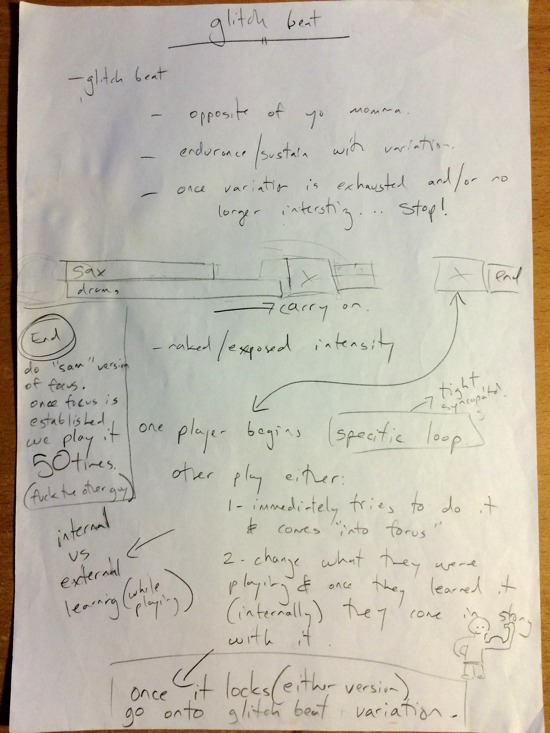
The form of glitch beat is similar to yo momma in that there is a type of material/behavior (A) that is punctuated by a reduction in density (B), before ending with a contrasting section (C). The A section begins suddenly and is made up of busy/frantic material (hence the title of the piece). During the A section the material is subtly transformed with slight variations, while keeping the same energy and movement throughout. The first two instances of the B section deal with external (audible) learning where the second performer must immediately play along with the contribution, phasing their playing into focus. The final B section, which leads into the C section, uses internal learning where the second player joins in as soon as they can, while staying fully locked in in the unison.
Here is a video recording of glitch beat recorded in the studio:
The ending (C) section of the piece serves not only as a contrast, but also as an exploration of repetition in a tangential way. The material from the last B section transition is repeated 50 times, with each performer keeping their own count. The use of extended repetition in this way was inspired by bands like the Zs and Orthrelm which feature long blocks of loud aggressive repetition. We wanted to incorporate that kind of run-on-sentence energy using improvised material. The contrast between the external and internal learning transitions makes the appearance of the C sudden and shocking, and the actual ending of the piece rarely has both of us stopping at the same time.
Here is a live version of glitch beat at The Noise Upstairs (feel free to count the repetitions at the end to see who ‘got it right’):
Here is the complete text/score/instructions for glitch beat:
Both performers begin by playing a busy/defined material. When one performer’s variations are exhausted and/or no longer interesting, they stop playing.
The other performer carries on playing. They cannot stop.
The performer who stopped composes a rhythm/phrase/melody/figure in their head and then begins playing it loudly/confidently. The other performer must immediately join in trying to play it in perfect unison. The moment that both performers have phased into they unison immediately start playing a new busy/defined material.
Repeat this cycle (busy/defined -> one performer stops -> unison rhythm) two more times, except, on the last repeat rather than trying to join in in unison immediately, internalize the rhythm/phrase/melody/figure and only begin playing it once you can do it perfectly.
Play the unison figure 50 times and stop. If the other performer stops first, carry on until you reach what you count as 50.
Along with yo momma, glitch beat is one of our favorite pieces to perform due to its simple, yet complex, ruleset. The overall form of glitch beat also retains a clear identity even though the material can vary wildly. This can be heard in the multiple versions presented here.
Here is the studio recording of glitch beat:
///////////////////////////////////////////////////////////////////////////////////////////////////////////////////////////////////////////////////////////////////////
flurries
flurries was born out of conversations about the Berlin and Stockholm improv scenes, which focus on quiet, spacious, and object-oriented improvisation, and the considerations of acousmatic music, specifically Trevor Wishart‘s ideas about the “sonic continuum” presented in this book and Dennis Smalley‘s ideas about spectromorphology in this paper. We wanted to challenge ourselves to work within this spectromorphological framework using quiet, tiny sounds, but in an improvised setting.
During the A section Sam and I both aim to create a single sound object made up of individual grains of sound: a sort of acoustic granular synthesis. The sounds that we use, as well as their overall density, are conceived as occupying a three-dimensional shape within a cube. The axes of the cube are density, color/timbre, and length. When we begin the piece we constrain ourselves to a fixed shape within this perceptual/parameter space. Each time we hear a flam, we individually morph to a new shape/position within this space, creating a complex spectromorphological mass.
Having to negotiate this 3D space while generating and maintaining an improvisational language is difficult, as is the case for most of the Battle Pieces; the fusion of spectromorphological and game thinking in flurries creates a kind of contradictory headspace. Sam describes this as “engaging two contradictory parts of your brain at the same time. Or, having to engage your brain while trying to keep this creative sort of flow going” (Andreae 2013). Such a rigid conceptual framework is not as present in other pieces where both of us try to avoid overthinking things, but in flurries “you have to keep very conscious of the structures and rules, but then that’s also the fun part” (Andreae 2013).
Here is a video recording of flurries in the studio:
flurries also marked a shift in the compositional thinking for the Battle Pieces. We began incorporating somewhat fixed compositional ideas in the form of sonically fixed materials and structural elements. The sonic materials and behaviors of the B section, as well as the ending, are far more defined than in other Battle Pieces. This fixity emerged as a response to the concern over always needing a contrasting “B section”, either in behavior or sound. flurries contains a contrasting B section, but it is of a different type and approach.
Here is the complete text/score/instructions for flurries:
flurries is broken into three sections: A, B, and A1. During the beginning A section, both performers use a variety of quiet sound sources to navigate the following sound quadrants.
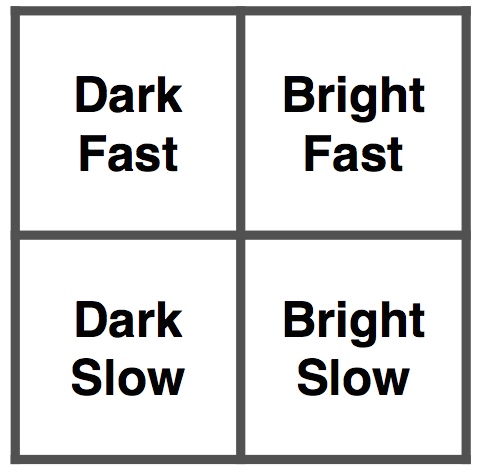
Each performer picks an area to occupy in quadrants. This area can have a variable size and shape. So it can be a pinpoint, or it can be a large oblong shape, spanning multiple quadrants. Whenever there is a perceived ‘flam’, each performer (independently) transitions to a new area in the quadrant grid. This change can happen instantly, or gradually.
When a unison happens during the A section, this signals the change to the B section. The B section is made up of sustained/textured sounds AND whatever sound event happened in the unison. Each performer uses metal implements to rub their instruments, creating the sustained/textured sound, and to cue each other to create unison events. This section ends when either player cues one final unison together.
After the final unison of the B section, the players return to the A section.
The two A sections (A and A1) do not happen on either side of the B section. There is an independent transition between them (the ‘pregnant pause’ described below), so that A1 can happen before the B section. Once the change to A1 takes place, the piece stays in that section until the ending of the piece.
The transition to the A1 section is the emergence of a ‘pregnant pause’, which is relative to the general activity and density level in the piece. After this pause, the quadrant grid turns into a three-dimensional space, with duration occupying the new axis. Flams continue to signify a transition to a new area.
During A1, when there is another unison sound, this signifies the change to the ending of the piece. A short metal scrape sound is made by both performers, in unison. Then, one performer makes stream of short, evenly-spaced events, while the other performer plays an irregular gesture over the top of it. The piece ends with these two streams of events fall on a unison.
Here is the studio recording of flurries:
///////////////////////////////////////////////////////////////////////////////////////////////////////////////////////////////////////////////////////////////////////
switches
For switches we wanted to explore tight unison playing in a rhythmic context, somewhat inspired by Sam Pluta‘s Switches, which I later learned and performed as a drummer. The unison playing that makes up the main body of switches comes in three main flavors:
- Unison stabs – both of us playing short/tight sounds
- Stabs + alternating stab/sustain – one of us playing short/tight sounds and the other playing alternating stabs and sustained sounds
- Trading stab/sustain – both of us alternating stabs and sustained sounds
The behaviors and dynamics used in the piece are determined by a series of six unpitched notes/events that happen at the start of switches. The combination of short or sustained sounds in the first three events determines the behaviors to be used in the three sections (A/B/C) of the piece. The duration between the next three sounds then determines the dynamics for those three sections (A/B/C).
Since we both improvise our own sound types during the exposition of the piece, we have no way of knowing what the behaviors and dynamics will be during the A/B/C sections of the piece. This creates a charged opening section as we are trying to play with each other while simultaneously decoding the information we pseudo-randomly encoded into the introduction. This tension overflows into the first section of the piece: we continue to process the opening in the background while trying to create meaningful/synchronous interaction in the foreground. This kind of encoding/decoding as material transformation is something that I revisited along in the context of memory in ialreadyforgotyourpussy.com.
switches was one of the first pieces where we noticed an almost immediate change in our general improvisational abilities. Since so much of switches is focused on executing punctuated stabs together, this honed our technical ability to play in this way, something that is an incredibly valuable skill in an improvised setting. Beyond that we also got really good at reading each other’s musical minds, not dissimilarly to how improvising comedians who work together often learn to speak at the same time during a game known as two headed expert.
Here is the complete text/score/instructions for switches:
Both performers begin by playing six unpitched events in unison. They can choose to play a short sound or a long sound, but must begin with each other regardless of the duration of their chosen event. The combination of the first three events determines the interaction modes used later in the piece and the duration of time between the last three events determines the dynamics of those sections (long = loud, short = soft).
The recipes for the first three events and subsequent modes of interaction are:

After the opening six events there are three block sections which adhere to the modes of interaction and dynamics determined in the introduction.
Here is a sketch version of switches before some of the larger scale structure was devised:
Here is the studio recording of switches:
///////////////////////////////////////////////////////////////////////////////////////////////////////////////////////////////////////////////////////////////////////
eat, eat everything
eat, eat everything was composed, along with sausage fest, during some of the last rehearsals before Sam moved away from the UK. This, combined with the long gap after our last compositions, meant that our ideas about Battle Pieces, and improvisation in general, had matured. As such the concept, structure, and mechanics of eat, eat everything are complex, taking many rehearsals to fully conceive and learn.
The core of eat, eat everything is the creation of special events, punctuation events, and event pairs. These are defined as follows:
- Special event – a sound that stands out from the improv backdrop in a remarkable way
- Punctuation event – a clearly identifiable sound that will be repeated throughout the piece
- Event pairs – when two special events are played: the first special event opens the pair, and the second special event closes it: there can be multiple open event pairs at once
The piece begins with each performer creating a punctuation event that is later used to signal an attempted score. Once this punctuation event has happened we begin a quiet, textural improvisation in an effort to create a backdrop that contrasts from the special events that will form the main game of the piece. Special events are peppered on top of this textural improv backdrop in an attempt to create event pairs with them. The idea is that you seed a special event and return to your improvising and then later try to perform the same special event again, effectively closing that event pair. Once an event pair is closed, you must perform your initial punctuation event. If the other performer does not play their punctuation event with you, you score a point. In this way, the special events and their event pairs create a kind of improvisational syntax in eat, eat everything.
Performing eat, eat everything requires memory juggling in a similar way to strains and ialreadyforgotyourpussy.com, especially with regard to how the performer’s memory space becomes saturated as the piece progresses. At any given moment I can have up to five event pairs open while simultaneously tracking several of Sam’s special events. The unpredictable nature of when these special events and their event pairs can happen produces an “anticategorical” strategy for memory sabotage where the events preclude easily chunkable patterns (Snyder 2001). This produces “a kind of ‘nuance overload,’ where every sound is a unique event and cannot easily be identified as being in the same category as another event”(Snyder 2001).
The overall form of the piece contains the same information presented three times: once in time, then out of time, and finally frozen in time. The A section of the piece is the in time section and consists of improvisation on top of which special events and event pairs are interspersed. The B section, which is the out of time section, only occurs if a tie score is reached, meaning that it does not always happen. During the B section, all of the special events that have taken place are played, without improv/accompaniment, in a super compressed time frame of around 10-15 seconds. This creates a structural hyper-reminder, quickly running us through all of the special events, including still open event pairs. The final (C) section takes the last special event and freezes it for the same duration as the previous A section, again engaging memory in an unusual way.
By running through the same material three (in/out/frozen) times you reinforce your own memory of the special events and event pairs, rightly or wrongly, creating a potentially false or perverted version of the events. On top of this memory fuzziness is played with in the game of the piece where you try to rub against this blurriness by creating usual patterns and pairings in the special events you seed. One thing that we (gentlemanly) agreed to avoid doing is opening the piece with a special event that you then hold on to until you have scored two points. This would allow you to instantly win the game by closing your “cheater’s” special event. Not classy.
Here is the complete text/score/instructions for eat, eat everything:
eat, eat everything is all about trying to create ‘event pairs’ out of ‘special events’ which are scored by executing ‘punctuation events’. These are all defined as follows:
- Special event – a sound that stands out from the improv backdrop in a remarkable way
- Punctuation event – a clearly identifiable sound that will be repeated throughout the piece
- Event pairs – when two ‘special events’ are played: the first ‘special event’ opens the pair, and the second ‘special event’ closes it: there can be multiple open ‘event pairs’ at once
Both performers begin the piece by performing a ‘punctuation event’ which is repeated every time a performer closes an ‘event pair’. After the opening ‘punctuation event’, the performers begin improvising in a quiet, textural manner. At this point they can begin introducing ‘special events’. It is possible to seed/open many ‘event pairs’ at the same time. When a performer closes an ‘event pair’ they performer their ‘punctuation event’. If the other performer does not join in the ‘punctuation event’, the performer who performed the ‘punctuation event’ scores a point. If the other performer does join in, then no point is scored. The first to 3 points wins the game. When a tie occurs (1-1 or 2-2) then the B section of the piece takes place. If no tie occurs the B section does not happen.
The B section takes all of the ‘special events’ that have happened, including open pairs, and plays them on their own, without accompaniment, in a sped up manner (10-15 seconds). Once the B section is completed, the performers return to A section behavior, with the open ‘event pairs’ still available for closure.
Once 3 points have been scored by one player the C section takes place. The C section takes the last ‘special event’ and freezes it (à la spectral freeze) for the full duration of the previous A section. The piece is over once the C section is complete.
Here is a rehearsal recording of eat, eat everything:
///////////////////////////////////////////////////////////////////////////////////////////////////////////////////////////////////////////////////////////////////////
sausage fest
sausage fest, like eat, eat everything was one of the last Battle Pieces we composed. As such it contains a complex and difficult ruleset which took several intense rehearsals to begin to understand. It would take several years of playing sausage fest and eat, eat everything to get to the chess-like gameplay we currently have with the older Battle Pieces like yo momma and glitch beat. That being said, even with the current understanding we have of sausage fest, it is an exciting, if tense, game/piece to play.
The main ideas that inspired sausage fest were silence and space. We wanted to compose a piece where silence/space/density played an important part of the improvisational language as well as the formal framework. The emphasis on silence/space in sausage fest gives it a unique sound among the Battle Pieces, albeit somewhat similar to flurries spectromorphological acoustic grain clouds. The Battle Pieces tend to have a manic energy that forms the foundation or subtext on top of which most of the compositions are built. sausage fest is a reaction against that.
If silence/space forms the grammar or language of sausage fest, trajectories and gestures form its syntax. Throughout the piece we try to keep track of notes (duration of performed material) and rests (duration of time between notes). Both of these parameters (notes/rests) can either increase or decrease in duration, and keeping track of these trajectories forms the main game of the piece. If you know what the current trajectories are and suspect the other performer does not, you can call out the other performer in an attempt to score. Keeping track of the subtle compression and expansion of the notes/rests falls into a murky perceptual/memory space similar to the perverted rhythmic memories in the end of strains or the confusing trajectories of sustain/silence in Feldman‘s Patterns in a Chromatic Field.
In order to score a point one player begins a gesture (call out) which is immediately joined by the second performer. If the second performer also knows the current trajectories they respond with a complimentary gesture (tick tick boom) to claim the point as their own. If no response is given, the player who initiated the call out scores the point. The call-and-response-ness of the gestures in sausage fest creates a punctuation not dissimilar to the event pairs in eat, eat everything, where periodic repetition frames the improvised material that makes up the body of the piece. Creating these cohesive gestures collectively is one of the most difficult aspects of sausage fest.
Unlike some of the ‘polite’ Battle Pieces (eat, eat everything, elbows, AB(B)A, pop song) where cooperation and sympathetic listening is encouraged, sausage fest is a more aggressive bluff/double-bluff game. This is amplified by the fact that every call out results in a point being scored. If a call out is made successfully, it scores a point, if it fails, the other performer scores the point. This creates a high-stakes gameplay environment where every move has dire consequences, especially since the game is won with only three points.
Here is the complete text/score/instructions for sausage fest:
sausage fest is all about keeping track of two separate sausages: the sausage of ‘sound’ and the sausage of ‘silence’.
Throughout the piece both performers improvise material that is relatively static in density and dynamic, and collectively play ‘sound sausages’. These ‘sound sausages’ can get shorter or longer as the piece progresses. At the same time, the gaps between the ‘sound sausages’ (‘silence sausages’) can also get longer or shorter. You must keep track of both of these trajectories. If you think the other performer does not know the current trajectories you can ‘call out’ the performer by performing an opening gesture, which the other performer must immediately join in with. If they do know what the trajectories are, they can respond with a ‘tick tick boom’ gesture, which you must immediately join in with. Every ‘call out’ scores a point one way or another. All gestures are played collectively, with special attention paid to creating a unified gesture and sound.
The game is over once three points have been scored. So, the actual ending of the piece comes from an unanswered ‘call out’ gesture or a closing ‘tick tick boom’ gesture.
In the event of a double ‘call out’, no point is scored, unless the score is tied at 2-2. In this case a double death occurs and two ‘tick tick boom’ closing gestures are played.
Here is a rehearsal recording of sausage fest:
///////////////////////////////////////////////////////////////////////////////////////////////////////////////////////////////////////////////////////////////////////
strains
strains is one of the most difficult Battle Pieces composed to date. The piece begins with a rock-paper-scissors type game where each performer has three sounds which are circularly dominant. Determining the winner of each round is not a simple task, and since each round has one less event than the previous round, the tensions builds over the course of the beginning. Once we have counted down to one event and a winner is determined, the winner begins the second half of the piece.
The second half of strains is where the title of the piece comes from. There are two interwoven strains of material that have to be juggled and developed as the structure of the piece moves forward. One strain consists of free improv, seeded by the winner of the first half. Each time the improv strain is returned to, the material from the previous instance is further developed. In this way the improv strain forms a singular improvisation which is interrupted by the second strain.
The second strain involves a complicated polyrhythm generated through call-and-response which needs to be performed in unison before and after each free improv section. Having to remember a complex polyrhythmic relationship that was improvised moments earlier is one of the most difficult things I’ve ever had to do as a performer. It is much harder than remembering an improvised sequence of pitches since “pitch help[s] you remember the slightly larger forms–the shape. You can group the pitch shape together more easily than the rhythmic shape” (Andreae 2013). This falls in line with how memory functions in music, described by Robert Snyder as “strategies for memory sabotage” in this book. The type of sabotage (unintentionally) explored in the second half of strains deals with “memory length strategies” where by “break[ing] up the continuity of the present [creates] situations in which short-term memory cannot perform its usual function” (Snyder 2001).
Through playing strains and specifically the complex memory game of the second half we came to an interesting realization about memory in the context of improvisation. Since there is no musical score, or objective version of reality (happening in real time anyways), memory takes on a different meaning. Perverted or misremembered memory becomes truth, both as a performer and as a listener. This volatile memory space functions similarly to Feldman‘s use of “crippled” memory, where small, almost imperceptible changes happen to the material, but, working outside of a notated (or referentially objective) context, the “crippled” memory becomes itself (Feldman 1981). It overrides and replaces itself. This perversion of memory was further developed and explored in other Battle Pieces and the .com pieces.
Here is the complete text/score/instructions for strains:
Strains is broken into two sections. During the first section of the piece the performers play a musical version of “rock, paper, scissors” with predefined low/mid/high sounds. The drummer counts in the first round and then both performers play their chosen low/mid/high sounds at the tempo established by the count in with the 7th note determining who wins the round. The winner counts in the next round which is played at that new tempo but is only 6 notes long. This pattern continues until only one note is heard. The winner of the final round begins the second section.
The second section begins with free improvisation. The loser of the first section can interrupt at any point by playing a repeating rhythmic cycle. The winner then interrupts that cycle with one of his own (at a new tempo) and finally the loser interrupts one more time. This forms a rhythmic phrase consistent of 3 tempos. The rhythmic phrase is then repeated in unison before going back to the free improvisation. At any point during the improvisation a performer may cue to play the previous rhythmic sentence in unison.
The following cycle forms the remainder of the piece with the performers choosing to end after any unison rhythmic sentence:
free improv -> (last rhythmic sentence in unison) -> building a new 3-section rhythmic sentence by interrupting each other -> unison rhythmic sentence -> free improv
Here is the studio recording of strains:
///////////////////////////////////////////////////////////////////////////////////////////////////////////////////////////////////////////////////////////////////////
elbows
elbows emerged as a variation of the yo momma idea of trying to force/create/steal/engineer a _____. In yo momma the object of the game is the creation of an ending: in elbows the object is the creation of a new section. We wanted to create a fast-paced improvisation with clear shifts in material, or elbows. The scoring structure is similar to yo momma as well, although the number of points that need to be scored is 5 instead of 3 since there is no B or ending section to the piece.
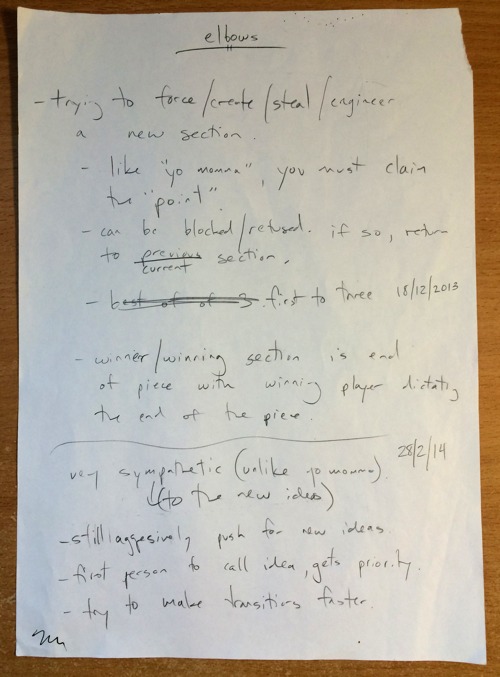
Because of our experience composing and performing yo momma and other highly competitive Battle Pieces, we placed more emphasis on blocked and refused elbows. In yo momma these manoeuvres emerged through rehearsal/performance, but in elbows the piece was composed around the knowledge that the gamesmanship would be taking place. Material that is introduced that does not organically emerge from what came before can be ignored or blocked. When this happens the performer who introduced the new material must return to the previous material, creating a formal structure similar to a rubber band being stretched and released.
Here is a live version of elbows filmed at The Noise Upstairs:
One big difference between elbows and yo momma is that elbows has more cooperative and sympathetic gameplay. Around this time we were starting to conceive Battle Pieces that involved more cooperation in their gameplay, and elbows is one of the first pieces composed with that mindset. Although elbows is intended to be fast-paced and aggressive, in order for the piece/game to work well, we need to be receptive to new material. Otherwise we could each bullheadedly hold onto existing material, artificially blocking all new material. In yo momma the appearance of an ending is clear and generally unambiguous, whereas this is much less the case with elbows.
Here is the complete text/score/instructions for elbows:
The piece begins with both performers playing. The objective of the game is to force/create/steal/engineer a new section of material. This must happen naturally, emergent from where the material currently is.
When a performer creates a new section they make a ‘thumbs up’ gesture to themselves, indicating claim to the transition. In the case of both performers calling the point the first performer to call the point gets priority.
New sections of material may be blocked or refused, in which case, the previous material is returned to. With that being said, the performers must be very sensitive and sympathetic to shifts in material, while aggressively pushing for new ideas.
The game continues until one player scores 5 points and is ahead by a margin of 2.
Here is the studio recording of elbows:
///////////////////////////////////////////////////////////////////////////////////////////////////////////////////////////////////////////////////////////////////////
AB(B)A
AB(B)A is one of several miniatures composed before we went into the studio to record most of the Battle Pieces. The piece is not competitive in any way but does contain some improvisational challenges due to its nature of requiring performers to create, find, and then reimplement a game. The idea for this came from some of the memory distortion/perversion games we explored in other Battle Pieces (strains particularly). We wanted to see if a spontaneously created/recalled game could be heard even if the musical material that occupied it was different.
Performing AB(B)A is generally fun because of its completely open material possibilities as well as the meta-game-ness of it: it is a game of establishing/finding a game. What is interesting is, as we have composed and performed more and more Battle Pieces, our understanding and ability to navigate complex games has increased, making the meta-game-play of this piece an increasingly complicated matter. Especially since we do not make our game explicit with body language. As a result, AB(B)A is one of the more surprising Battle Pieces to play.
Here is the complete text/score/instructions for AB(B)A:
Both performers begin freely improvising. During this section the performers try to develop and discover a musical “game” using only musical communication. This exploration should not be overt, and should emerge naturally. This is the “A” section of the piece. Once the game is discovered the performers transition to an unrelated “B” section.
After an appropriate amount of time, return to the “A” section, but using a different kind of sonic material, so the only thing that survives is the “game” itself.
Here is the studio recording of AB(B)A:
///////////////////////////////////////////////////////////////////////////////////////////////////////////////////////////////////////////////////////////////////////
pop song
pop song is another of the miniatures composed before going in to the studio to record most the Battle Pieces presented here. pop song is similar to AB(B)A in that there is no competitive element; something we started to explore in some of the latter Battle Pieces. The central idea of pop song is the exploration of memory and repetition in improv through the vehicle of pop song form. The inclusion of so much repetition here is a deliberate attempt to “fix” this tendency, or lack thereof, in our own improvisations. Improvisers rarely repeat the same exact material, much less in a vanilla pop song form.
pop song, like AB(B)A, is a very fun piece to perform, largely for the same reasons. The content is so wide open, although the challenge (memory/repetition) always remains the same. And as simple as the form is, when performed in a purely improvised context, it is surprisingly difficult to implement.
Here is the complete text/score/instructions for pop song:
Both performers begin by creating a relatively short phrase that they exactly repeat, while in sync, 8 times. This represents the ‘verse’ of the song. A ‘pre-chorus’ is then created, which is repeated 4 times. Following this is 8 repetitions of a ‘chorus’.
This whole cycle (verse, pre-chorus, chorus) is repeated twice, using the same material both times.
After this follows an unrelated ‘bridge’ of unidentified length.
After the bridge, the original chorus is repeated 16 times.
After the final ‘double chorus’ an outro is performed.
Entire structure:
Verse (x8), Pre-Chorus (x4), Chorus (x8)
Verse (x8), Pre-Chorus (x4), Chorus (x8)
—Bridge—
Chorus (x16)
—Outro—
Here is the studio recording of pop song:



